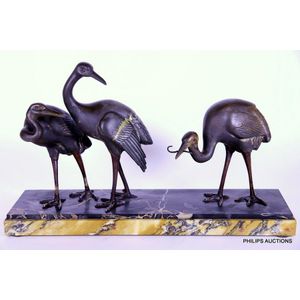Spelter Stork Trio by Irenee Rochard
An Art Deco spelter animalier group of three Storks by Irenee Rochard, (1906-1984), three feeding storks, one with a small snake in its beak, and mounted on a two tone yellow ochre and portoro marble base, signed I. Rochard across one, corner, height 30 cm, length 50 cm, width 13.5 cm
You must be a subscriber, and be logged in to view price and dealer details.
Subscribe Now to view actual auction price for this item
When you subscribe, you have the option of setting the currency in which to display prices to $Au, $US, $NZ or Stg.
This item has been sold, and the description, image and price are for reference purposes only.
- Les Animaliers - Les Animaliers is a term used to describe a movement in French sculpture and decorative arts in the late 19th and early 20th centuries that focused on the depiction of animals. The movement was led by a group of artists known as the Animaliers, who were known for their highly realistic and anatomically accurate sculptures of animals. Many of the Animaliers were trained as taxidermists, and their work was influenced by the naturalist movement, which sought to accurately depict the beauty and diversity of the natural world. The Animaliers were particularly known for their bronze sculptures of animals, which were often cast using the lost-wax process and finished with a patina to give them a naturalistic appearance. The Animaliers' work was popular with collectors and the general public, and it continues to be admired for its attention to detail and technical skill.
- Spelter - Spelter was the name given to an alloy of zinc and brass or copper used in the 19th century for statuary and lighting. It is a brittle bluish-white metal. It was used as a cheap replacement for bronze, but being brittle easily breaks and can't be repaired. When finished it can often be mistaken for bronze, but if discreet a scratch on the base displays shows a greyish colour, the metal is spelter, if a golden colour the metal is most likely bronze.
- Art Deco Period - The Art Deco period was a cultural movement that emerged in the 1920s and 1930s, and was characterized by its emphasis on modernism, luxury, and elegance. The name "Art Deco" comes from the Exposition Internationale des Arts Décoratifs et Industriels Modernes, a large exhibition held in Paris in 1925 that showcased the latest trends in decorative arts.
Art Deco was a reaction against the ornate and elaborate styles of the previous era, and reflected a new modern sensibility. It was characterized by streamlined, geometric shapes, bright colours, and the use of new materials such as chrome, glass, and Bakelite. Art Deco designers sought to create a sense of luxury and sophistication, often incorporating expensive materials such as ivory, marble, and rare woods.
Art Deco had a significant impact on a wide range of artistic fields, including architecture, fashion, graphic design, and interior design. Some of the most iconic examples of Art Deco architecture include the Empire State Building in New York City, the Hoover Building in London, and the Palais de Chaillot in Paris.
The Art Deco period came to an end in the 1940s, as World War II and changing cultural trends led to a shift in artistic styles. However, Art Deco remains an important influence on design and art, and continues to be celebrated for its modernist sensibility and glamorous aesthetic.
This item has been included into following indexes:
Visually similar items

A pair of large bronze models of cranes, Japanese circa 1950, 87 cm and 72 cm high
Sold by
in
for
You can display prices in $Au, $US, $NZ or Stg.

A large Japanese bronze model of a crane, Meiji Period (1868-1912), 107 cm high
Sold by
in
for
You can display prices in $Au, $US, $NZ or Stg.

Two patinated bronze cranes, realistically cast, each with turning neck (2)
Sold by
in
for
You can display prices in $Au, $US, $NZ or Stg.

A pair of Japanese early 20th century bronze heron sculptures, for garden placement. Tallest 105 cm Later fixed to wooden base.
Sold by
in
for
You can display prices in $Au, $US, $NZ or Stg.
